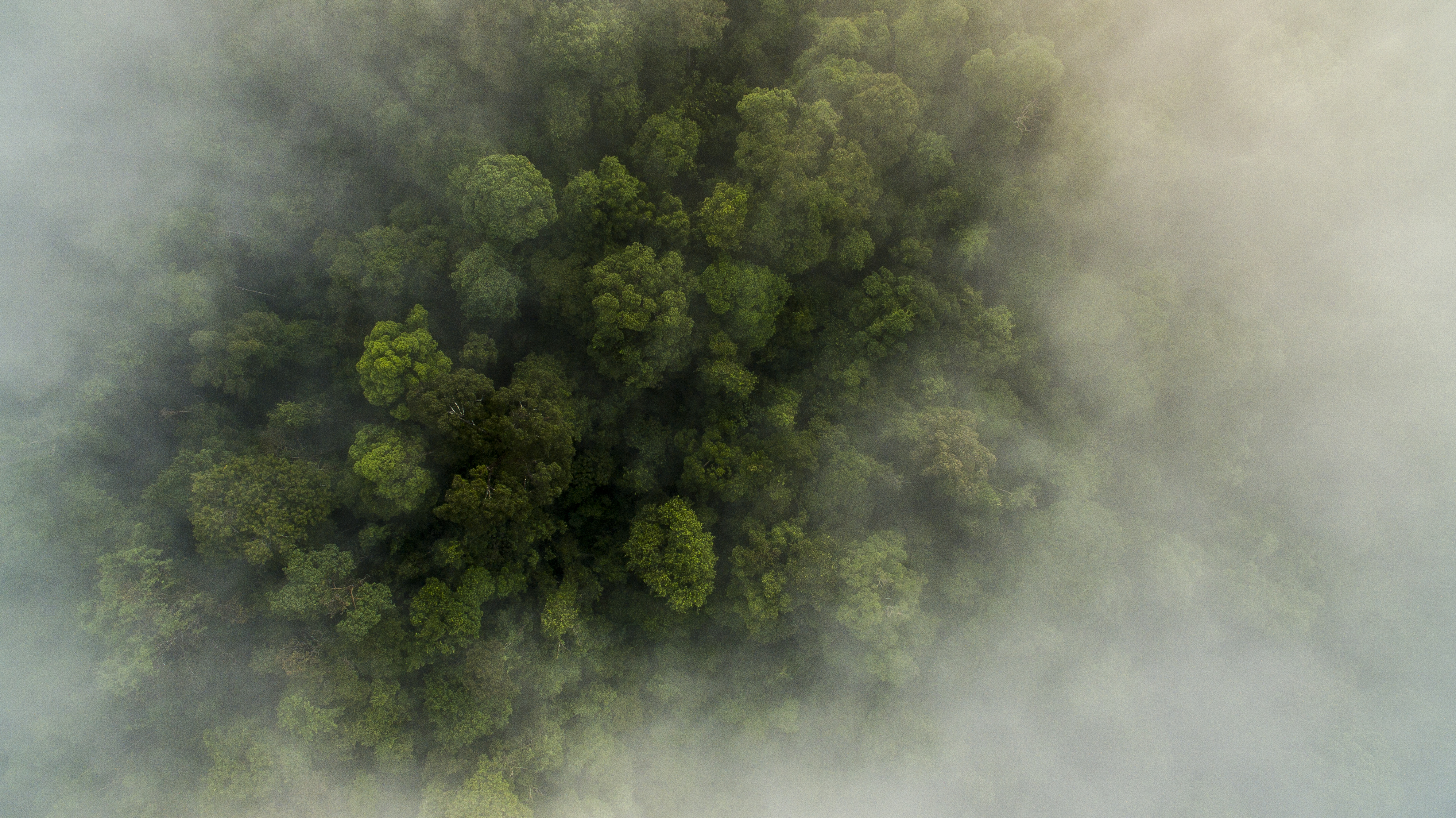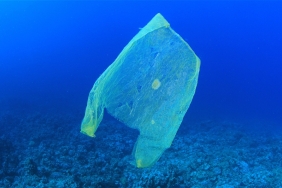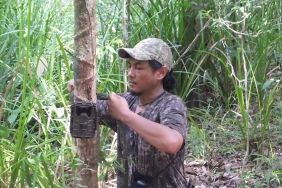CELEBRATING 72ND INDEPENDENCE DAY IN KEBUN TINGGI
By: Syamsidar
A steep, winding road full of muddy climbs and descents finally brought us to Kebun Tinggi Village, Kampar Kiri Hulu District, Kampar, Riau. Our arrival was welcomed by the residents who were gathered at the soccer field watching the inter-village match in commemoration of the 72nd Indonesian Independence Day. The Head of Kebun Tinggi Village, Joni Antoni, who was mingling with his residents, also greeted us warmly.
The tiring journey that occasionally makes the heart pounding to cross the edge of a steep cliff takes approximately 8 hours from Pekanbaru is gone with the cool breeze of the afternoon air in the village. Due to two car breakdowns, our trip took 1.5 hours longer than the estimated mileage we had planned. Treats of hilly landscapes on the left and right of the road with dense tree stands and the curves of the hills that seemed to reach the clouds melted our grumbling, all that was said was admiration for the beautiful nature that lay.
"It feels like a trip to the West Sumatra area, surrounded by beautiful scenery," I said to my partner in the car when our car followed the curve of the road.
Along the way after entering the intersection towards Kuntu from the direction of Lipat Kain, Kampar Kiri, we had to cross the dirt road although in some parts it was paved, especially around residential areas. Half of the journey was slippery because of the rain. After passing through several villages, we finally reached Lubuk Bigau Village, which is known as the village where the highest waterfall in Riau is located. The village is approximately 1 km away from Kebun Tinggi village and is only separated by a small tributary.
The waterfall is located in the Bukit Rimbang Bukit Baling landscape which is a global tiger habitat priority area that needs to be maintained for the survival of the Sumatran tiger. From a study conducted by WWF in collaboration with BBKSDA Riau in this landscape, it was proven to be inhabited by Sumatran tigers from the results of camera traps placed at several research points. In addition, various types of rare animals were also recorded in this area such as Sumatran forest goats.
In the evening, we coordinated with the Village Secretary, Tete Muhadar, to plan activities with the community to celebrate the 72nd Anniversary of the Republic of Indonesia. We filled in folk games for elementary and junior high school children in this village and participated in the 72nd Anniversary flag-raising ceremony.
As one of our plans was to raise the red and white flag at Batang Kapas waterfall, believed to be the highest waterfall in Riau, we coordinated with the village secretary. Five students from Kebun Tinggi Village's one-roof junior high school also joined us in heading to the waterfall. On two-wheeled vehicles, our group of 10 people and five junior high school students were escorted by local residents to the last access that could be passed by two-wheeled vehicles. On the motorbike, which passed through ups and downs and several suspension bridges, the motorbike rider who drove me mentioned "There is the waterfall, it looks close but is actually far away". From a distance, the cliffs of the waterfall can be seen. "If we walk there 1.5 hours but if people come it can be 3 hours", continued Mr. Tarmizi, the driver of my motorcycle ride.
And the climb began when we got off the motorcycle, through the dense forest, crossing the river, climbing over the fallen wooden trees we passed until we climbed the wooden steps that had been provided by residents as one of the facilities available to the waterfall. We passed several stone niches, which were also used as resting places before continuing the climb. After 3 hours of climbing through various steep inclines, we finally arrived at Batang Kapas Waterfall. Only puja and praise of gratitude for the beauty of nature that is seen in front of the eyes. The towering cliffs where the waterfalls poured out, large rocks holding the waterfalls showed the majesty of this waterfall.
The mission was immediately carried out several team members began to walk along the large rocks to the location in the middle to raise the red and white flag. The cold water and wind that hit did not melt the spirit of the team to raise the Red and White flag at the highest waterfall in Riau. By resting on the big rocks, the team also managed to develop the flag.
Not a single tired face could be seen from the high school students; Yeni, Yola, Nando, Rahmat, Raymond. They were happily enjoying the beautiful nature around them. We also shared a bit about the importance of protecting the forest with them and they were proud of the highest waterfall around them.
Independence Day ceremony and traditional games
The next day, at 8:00am, residents gathered at the Kebun Tinggi village soccer field for a red and white flag-raising ceremony led by the village head. Even though it was held by elementary and junior high school children, which in total amounted to no more than 120 people, Ri's anniversary ceremony went smoothly and solemnly. Village officials and representatives of residents who participated in the ceremony also looked enthusiastic.
After the ceremony, the soccer field was turned into an arena of excitement because it was filled with various folk games and cohesiveness such as the race to pull betel nut fronds, eat crackers, fill leaky paralon and others. The cheerful faces of the mothers who laughed out loud on the sidelines watching the excitement of the game were clearly visible, especially when given an additional party to pull betel nut fronds between mothers. Various jokes filled the day until late afternoon before finally continuing with the soccer competition between hamlets.
The evening was a night of fun because it was filled with prize distribution but also farewell from the WWF team who was present for 3 days in the village to return to Pekanbaru the next day. A tight and warm handshake filled the end of the meeting that night with the hope that we will be able to return to the village as soon as possible considering the conversation with the village head and residents who stated that so much potential is still stored in their village. "There are still several waterfalls around here, indeed those that have been exposed to the Batang Kapas waterfall but actually that's not all that is here so come back here," said the Village Head.
Gambir and the People of Kebun Tinggi Village
In addition to its natural charm, Kebun Tinggi Village and several villages in Pangkalan Kapas have unexpected wealth. For a long time, people in this area have been growing gambier to support the family economy and the prospects are very good. "In the past, the gambier's prime was Rp.120,000 / kilo," said Muhtiar, a gambier farmer.
"Now the price has fallen to around Rp.40,000-50,000 per kilo," he continued. This economic source is very promising because farmers can harvest gambier 3 times a year. For 1 ha of gambier plantation, if well cared for, it can produce 1.8 tons of dried gambier. The work is not difficult because gambier does not require intensive care, it only needs to be cleaned around it from wild plants then the gambier will grow well. After picking the gambier will be distilled and then dried which takes approximately three days until it is finally ready for sale.
"There is a token who comes here from West Sumatra to buy," Muhtiar said. However, he and several other residents also admitted that there is a price and quality game at this level, causing the price of gambier to fall, no longer like in its prime which could reach Rp 120,000 / kilo.
In Kebun Tinggi Village itself, there are about 30 ha of gambier plantations that have been managed by the villagers for a long time. And it seems that this habit is still continuing as evidenced by the existence of several new plantation openings that are planned to grow gambier. Riau is known for its palm oil but here there is a different view because there is a gambier plantation here.





